-
Paper Information
- Paper Submission
-
Journal Information
- About This Journal
- Editorial Board
- Current Issue
- Archive
- Author Guidelines
- Contact Us
Journal of Safety Engineering
p-ISSN: 2325-0003 e-ISSN: 2325-0011
2019; 8(1): 28-35
doi:10.5923/j.safety.20190801.03

Comparative Evaluation of Radiological Safety for Gamma Radiation Level at Some Radiation Facilities
M. Shamsuzzaman1, J. Saha2, M. M. H. Bhuiyan1, M. Sohel Rana1, A. S. M. Habibullah Khan3, M. S. Rahman1, D. Paul1, D. R. Sarkar2
1Institute of Nuclear Science and Technology, Atomic Energy Research Establishment, Savar, Dhaka, Bangladesh
2Department of Physics, Jagannath University, Dhaka, Bangladesh
3Planning Division, Bangladesh Atomic Energy Commission, Dhaka, Bangladesh
Correspondence to: M. Shamsuzzaman, Institute of Nuclear Science and Technology, Atomic Energy Research Establishment, Savar, Dhaka, Bangladesh.
| Email: |  |
Copyright © 2019 The Author(s). Published by Scientific & Academic Publishing.
This work is licensed under the Creative Commons Attribution International License (CC BY).
http://creativecommons.org/licenses/by/4.0/

Radiological safety is a key issue for the occupational worker as well as public during operational and non-operational exposure in a radiation facility. In this perspective radiological safety was evaluated in terms of Annual Effective Dose (AED) at some radiation facilities by Survey Meter Measurement (SMM) and Thermo-luminescence Dosimeter (TLD). This study focused on AED estimation corresponding to the facility specific operational and background radiation level at some strategic points in order to verify the compliance with the recommended guideline of International Atomic Energy Agency (IAEA). Hence, radiological safety was verified in accordance with the IAEA’s recommended AED limits of 20 mSv/yr, 6 mSv/yr, 1 mSv/yr for occupational worker, trainee and public respectively. The AED were measured in and around the Central Radioactive Waste Processing and Storage Facility (CWPSF), Research Reactor Facility (RRF), Secondary Standard Dosimetry Laboratory (SSDL) and Radioisotope Production Division (RIPD). The estimated AED at some points of RRF were found slightly lower than the IAEA’s recommended limit for occupational worker with an exception for the trainee and public. In other studied facilities, the estimated AED were found remarkably lower than the IAEA allowable limits for occupational worker, trainee and public. The estimated AED of SMM and TLD were compared to verify their compliance, and a reasonable agreement was observed. The main purpose of this study is to explore that exposures are kept as low as reasonably achievable and that the authorized limits confirming to IAEA recommendations are not exceeded.
Keywords: Radiation, Radiological, Dose, Thermo-luminescence, Occupational, Operational, Survey Meter Measurement, Annual Effective Dose
Cite this paper: M. Shamsuzzaman, J. Saha, M. M. H. Bhuiyan, M. Sohel Rana, A. S. M. Habibullah Khan, M. S. Rahman, D. Paul, D. R. Sarkar, Comparative Evaluation of Radiological Safety for Gamma Radiation Level at Some Radiation Facilities, Journal of Safety Engineering, Vol. 8 No. 1, 2019, pp. 28-35. doi: 10.5923/j.safety.20190801.03.
Article Outline
1. Introduction
- The Radiological safety in a nuclear facility needs to be ensured to protect the workers, public, and environment from radiation hazardous by means of exposure control through proper operating conditions of nuclear installation, prevention of accidents or mitigation of consequences of accident [1]. Radiological safety essentially focuses on the safe use of nuclear energy so that radiation shall not cause hazards to public, or damage to the environment or property [2]. Accordingly, the radiation safety of the employees and the environment shall be ensured in the design of a nuclear facility. The objective is to keep the radiation doses of workers as low as practically possible as per international recommendation [3]. Radiation monitoring shall be available to a sufficient extent during all stages of a nuclear facility’s life cycle where radioactive substances may occur at the facility. Practical radiation measurement using calibrated radiation protection instruments is essential in evaluating the effectiveness of protection measures, and in assessing the radiation dose likely to be received by individuals. Radiation monitoring involves the measurement of radiation dose or radionuclide contamination for reasons related to the assessment or control of exposure to radiation or radioactive substances, and the interpretation of the results. Occupationally exposed workers need to have a basic awareness and understanding of the risks posed by exposure to radiation and the measures for managing these risks. Ionizing radiations cannot be seen, felt or sensed by the human body in any way but excessive exposure to them may have adverse health effects. Radiation measuring instruments are needed in order to detect the presence of such radiations and avoid over limit exposure. The use of appropriate and efficient instruments enables exposures to be controlled and the doses received to be kept as low as reasonably achievable as per recommended dose limits [4]. Dose limits are set to protect workers and members of the public from the effects of ionizing radiation. They are set at a level that balances the risk from exposure with the benefits of using ionizing radiation. The fundamental requirement for employers is to reduce all exposure to ionizing radiations to as low a level as possible and this should be below the recommended dose limits of 20 mSv/yr for worker, 6 mSv/yr for trainee and 1 mSv/yr for public [3,5,6]. The implementation of workplace radiation monitoring and the use of individual dosimeters, such as thermo-luminescence dosimeter (TLD), are essential measures for the preliminary assessment of the dose rates in the worker position and the confirmation of worker absorbed dose, respectively [4,7]. In order to provide data for decision making about operational measures and the protection of the workers and the environment, an annual activity report needs to be evaluated to prevent high doses and continuously support the safety improvement that are necessary in concern to radiological safety assessment [8]. In this perspective the present radiological study was carried out to analyze the prevailed radiation level in some radiation facilities in order to develop a database for radiological protection of the worker in accidental scenario. This study aims to evaluate the accumulated effective dose through TLD technique and verification of the prevailed dose rates obtained by the area monitoring with survey meters. A comparative assessment was performed as well between the verified dose rates TLD techniques and survey meter method. The purpose of this study is to verify the radiological safety aspects of some radiation facilities in terms of recommended annual effective dose limit.
2. Methods and Instrumentation
- Radiation detection and measurement were performed at some prearranged strategic points through workplace radiation monitoring technique [9-14]. As per the regulatory requirement, some workplaces which contain radioactive sources are monitored to ensure safe working environments for worker. Area monitoring is important to establish the classification of working area accordingly. In this workplace monitoring both SMM and TLDs were used. The TLDs were placed at some strategic points for a certain time to be exposed in the radiation field. Simultaneously, the annual effective dose for the existing radiation level was determined by a hand held survey meter to detect and quantify the radiation levels [15]. A calibrated Geiger Muller detector based survey meter was arranged for the monitoring of radiation intensity of the radiation field per unit time. The survey meter deployed in this measurement is calibrated at the SSDL of Bangladesh. The TLD dosimetry was performed along with workplace monitoring technique to fulfill the requirement of individual monitoring. This is because individual monitoring is a prerequisite to measure the radiation doses received by individuals working in a radiation facility [16]. In this point of view, the TLDs were utilized as well to investigate the total radiation dose received by an individual. Nowadays, due to technological breakthroughs and discoveries, most dosimetry is accomplished by using TLDs, which use the electron trapping capabilities of various crystals to measure dose received by the individual wearing the TLD.
3. Results and Discussion
- The present study reveals the measured breakthrough on the operational radiation levels in and around some radiation facilities, namely CWPSF, RRF, SSDL and RIPD. The results of the estimated AED for operational radiation level at these facilities are presented in the Figure 1 to Figure 13. The AED features for non-operational background radiation level were estimated at those radiation facilities as well. The comparative assessment of AED for the operational and non-operational background radiation levels among those facilities is presented and Figure 14 and Figure 15. The radiological safety of the occupational worker occupied with the existing operational radiation levels at these strategic points of CWPSF, RR, RIPD and SSDL facilities was evaluated in comparison of the recommended AED limit of the IAEA. The AED were estimated by both survey meter measurement (SMM) and thermo-luminescence dosimeter (TLD) techniques. Subsequently, comparative assessments were performed between TLD and SMM technique. The estimated radiation dose rates of the TLDs were compared with the survey meter dose rates to verify the gradation of compliance. In some cases the TLD estimated doses were higher than that of the SMM technique. However, the IAEA’s recommended occupational annual dose limit was not exceeded by considering this overestimated TLD measured dose. The present study implied on the radiological safety performance of the occupational worker in terms of estimating the AED of the radiation facilities. In this assessment, both the non-operational background and operational radiation level at some radiation facilities were investigated, which are CWPSFRIPD, SSDL, and RR. In some cases the TLD estimated doses were higher than that of the SMM technique. However, the annual dose limit of the IAEA’s recommended occupational dose limit was not exceeded by considering this overestimated TLD measured dose with an exception in the case of operational mode of the RR facility. The estimated AED of CWPSF was found relatively high than that of the SSDL facility. Similarly, the estimated AED of the RIPD was found relatively low than that of the RR facility. For all the studies facilities, the estimated AED was found within the recommended annual dose limit of the international atomic energy agency (IAEA). The detailed comparative assessment between the SMM and TLD measurement for individual facility is described in the subsequent sections.
3.1. Radiological Dose Assessment at the Central Radioactive Waste Storage and Processing Facility (CWPSF)
3.1.1. AED Estimation for Operational Circumstantial Radiation at SRSSF of CWPSF
- The AED were estimated for the radiation level on the outer wall of sealed radiation source storage room (SRSSF), inside of SRSSF, and inside of low and intermediate waste storage room (LILWSR) of CWPSF by both SMM and TLD techniques for two week duration. Subsequently, comparative assessments were performed between these techniques for respective strategic points, as shown in Figure 1 to Figure 3. From Figure 1 it is seen that the AED values of SMM at the outer wall are under estimated than that of the TLD estimated AED for the SRSSF. The TLD estimated AED at the outer wall of CWPSF was compared with the IAEA’s annual dose limit as shown in Figure 1. The measured maximum AED was found to be 860.238 µSv which was not exceeded the annual dose limit of the IAEA’s recommended occupational dose limit.
 | Figure 1. Comparison of experimental and recommended AED limit for the radiation level at outside wall and roof of SRSSR of CWPSF |
 | Figure 2. Comparison of experimental and recommended AED limit for the radiation level inside the SRSSR of CWPSF |
3.1.2. AED Estimation for Operational Circumstantial Radiation at LILSR of CWPSF
- The AED for the LILWSR of CWPSF were measured for the TLD exposure time two weeks. Subsequently, comparative assessments were performed between TLD and SMM technique, as shown in Figure 3. From this Figure it is seen that the SMM estimated AED values are closely equal to the TLD estimated AED with a little exception at point-5. The SMM and TLD estimated AED at LILWSR of CWPSF was compared with the IAEA’s AED limit as shown in Figure 3. The maximum AED was found to be 13520.00 µSv which was not exceeded the annual dose limit of the IAEA’s recommended occupational annual dose limit. The SMM and TLD estimated AED at CWPSF was found relatively high than the IAEA’s recommended dose limit for trainee and public. Nevertheless, the trainees are recommended to stay relatively short time than 8 hours/day at any locations of CWPSF. Moreover, public entrance at the CWPSF is not recommended unless any authorization.
 | Figure 3. Comparison of experimental and recommended AED limit for the radiation level inside the LILWSF of CWPSF |
3.2. Radiological Dose Assessment at the TRIGA MARK-II Research Reactor Facility (RRF)
3.2.1. AED Estimation for Background Radiation of TRIGA MARK-II RRF
- The AED were estimated for the radiation levels at two meter distance around the core of TRIGA MARK-II Research Reactor for one week exposure from background radiation while reactor was non-critical. Subsequently, comparative assessments were performed between TLD and SMM technique, as shown in Figure 4. From this Figure it is seen that the SMM estimated AED values are under estimated than that of the TLD estimated AED. Then the SMM and TLD estimated AED around the core when TRIGA MARK-II Research Reactor was compared with the IAEA’s annual dose limit (Figure 4). The maximum AED was found to be 780.00 µSv which certainly belongs to the annual dose limit of the IAEA’s recommended occupational dose limit.
 | Figure 4. Comparison of experimental and recommended AED limit for the background radiation level around the reactor core of RR facility |
3.2.2. AED Estimation for Operational Radiation of TRIGA MARK-II RRF
- The AED were estimated for existing radiation level around the reactor core during the operational condition of TRIGA MARK-II Research Reactor. The radiation AED were performed between TLD and SMM technique, as shown in Figure 5. From this figure it is seen that the SMM estimated AED values are under estimated than that of the TLD estimated AED. The TLD estimated maximum AED at operational condition was found to be 19280.00 µSv which belongs to the annual dose limit of the IAEA’s recommended occupational dose limit. Thus, this AED rate is acceptable for the occupational workers for their daily works at this RR facility. The SMM and TLD estimated AED around the reactor core was found relatively high than the IAEA’s recommended dose limit for trainee and public. Nevertheless, the trainees usually spend less long time than 8 hours/day around the reactor core during operational mode of RR. Further, public entrance is generally not recommended at the reactor core location. In a comparative view, the background radiation level is significantly lower than the operational radiation level which is evident from Figure 4 and Figure 5.
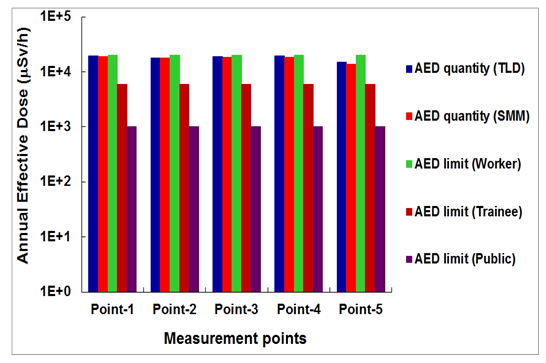 | Figure 5. Comparison of experimental and recommended AED limit for the radiation level around the reactor core of RR facility |
3.3. Radiological Dose Assessment at Secondary Standard Dosimetry Laboratory
3.3.1. AED Estimation for Background Radiation of OB-34 (Cs-137) Calibrator
- The AED for background radiation were estimated at SSDL during non-operational condition of 200 mci Cs-137 source of OB-34 calibrator by both SMM and TLD techniques. A comparative view of the AED between TLD and SMM technique is shown in Figure 6. The TLD estimated AED for background radiation from 200 mci Cs-137 source of OB-34 Calibrator was compared with the IAEA’s annual dose limit (Figure 6). The TLD estimated maximum AED was found to be 500.00 µSv which is significantly less than the IAEA’s recommended occupational annual dose limit.
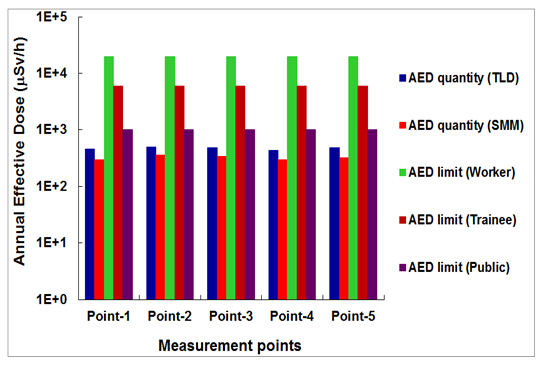 | Figure 6. Comparison of experimental and recommended AED limit for the background radiation level from OB-34 calibrator at the control room of SSDL |
3.3.2. AED Estimation for Operational Radiation of OB-34 (Cs-137) Calibrator
- In operational radiation level, AED were estimated at the operator’s position for the radiation level of 200 mci Cs-137 source of OB-34 calibrator by both SMM and TLD techniques. The TLD estimated AED is compared with SMM technique as shown in Figure 7. In the operational condition of OB-34 calibrator, the estimated AED for 200 mci Cs-137 radiation source was verified in terms of the IAEA’s annual dose limit (Figure 7). The TLD estimated maximum AED was found to be 780.00 µSv which is obviously less than the IAEA’s recommended occupational annual dose limit.
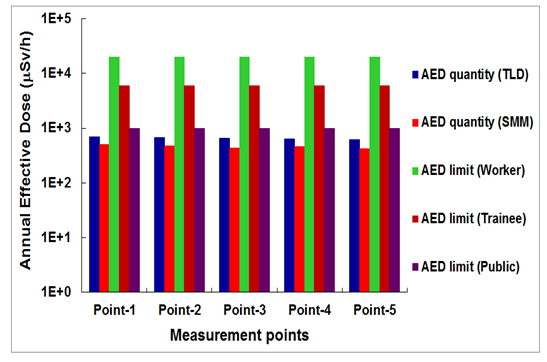 | Figure 7. Comparison of experimental and recommended AED limit for the radiation level at the control room of OB-34 calibrator |
3.3.3. AED Estimation for Background Radiation of G-10 (Cs-137) Calibrator
- The SMM and TLD based AED for background radiation was estimated at SSDL during non-operational condition of 20 ci Cs-137 source of G-10 calibrator. A comparative assessment between SMM and TLD estimated AED is shown in Figure 8. The TLD estimated AED for background radiation from 20 ci Cs-137 source of G-10 calibrator was compared with the IAEA’s annual dose limit (Figure 8). The TLD estimated maximum AED was found to be 700.00 µSv which is significantly less than the IAEA’s recommended occupational annual dose limit for the worker, public and trainee.
 | Figure 8. Comparison of experimental and recommended AED limit for the background radiation level at the control room of G10 calibrator |
3.3.4. AED Estimation for Operational Radiation of G-10 (Cs-137) Calibrator
- In operational radiation level, AED were estimated at the operator’s position for the radiation level of 20 ci Cs-137 source of G-10 calibrator by both SMM and TLD techniques. The TLD estimated AED is compared with SMM technique as shown in Figure 9. In the operational condition of G-10 calibrator, the estimated AED for 20 ci Cs-137 radiation source was verified in terms of the IAEA’s annual dose limit (Figure 9). The TLD estimated maximum AED was found to be 1500.00 µSv which is obviously less than the IAEA’s recommended occupational annual dose limit.
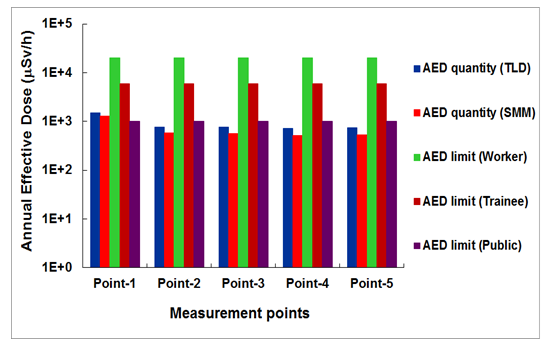 | Figure 9. Comparison of experimental and recommended AED limit for the radiation level at the control room of G10 calibrator |
3.4. Radiological Dose Assessment at Radioisotope Production Laboratory
3.4.1. AED Estimation for Background Radiation of Tc-99m Production Facility
- The estimated AED for background radiation exposure inside Tc-99m production facility were estimated by SMM and TLD techniques. Subsequently, comparative assessments between TLD and SMM for of AED were performed, as shown in Figure 10. From this figure it is seen that the SMM values are under estimated than that of the TLD estimated AED. The TLD estimated AED for background radiation inside Tc-99m production facility was compared with the IAEA’s annual dose limit (Figure 17). The maximum AED was found to be 680.00 which was far below the IAEA’s recommended annual dose limit. In addition, both the SMM and TLD estimated AED was found comparably lower than the AED limit of trainee and public.
 | Figure 10. Comparison of experimental and recommended AED limit for the background radiation level at the Tc-99m production hot cell room |
3.4.2. AED Estimation for Operational Radiation of Tc-99m Production Facility
- In the course of Tc-99m radioisotope production, AED were estimated by TLD and SMM technique at one meter distance from the Tc-99m production hot cell facility at gonad height. Subsequently, comparative assessments were performed between TLD and SMM technique, as shown in Figure 11. From this figure it is seen that the AED for SMM are under estimated than that of the TLD estimated AED. The TLD estimated maximum occupational AED was found to be 760.00 µSv for operational radiation level of Tc-99m production tenure which is lower than the IAEA’s recommended occupational dose limit. Since the AED for Tc-99m production satisfies the annual dose limit of the IAEA, thus, this AED is tolerable for the occupational workers for their involvement with the routine radioisotope production activity. The TLD estimated AED was even relatively lower than the AED limit of the trainee and public. The AED for operational and background radiation levels are compared and presented in Figure 10 and Figure 11. From these graphs it is evident that the background radiation level is significantly lower than the operational radiation level.
 | Figure 11. Comparison of experimental and recommended AED limit for the radiation level at the Tc-99m production hot cell room |
3.4.3. AED Estimation for background Radiation of I-131 Production Facility
- In the course of I-131 radioisotope production radiological safety was evaluated in terms of AED for occupational worker. In this perspective, AED for background radiation exposure around the I-131 production hot-cell facility were estimated by SMM and TLD techniques. Accordingly, TLD estimated AED was compared with SMM technique, as shown in Figure 12. This figure indicates that although the SMM measurements are slightly undervalued, however it is closely comparable with TLD estimated AED. In this case, the TLD estimated maximum AED was found to be 480.00 µSv which is lower than the IAEA’s recommended annual dose limit for worker, public and trainee.
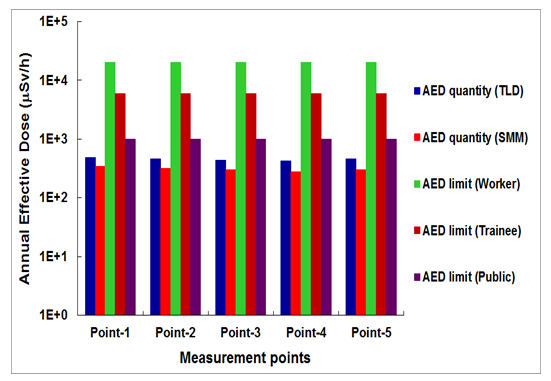 | Figure 12. Comparison of experimental and recommended AED limit for the background radiation level at the I-131production hot cell room |
3.4.4. AED Estimation for Operational Radiation of I-131 Production Facility
- The AED were estimated for the radiation level in I-131 radioisotope production. The AED were estimated by TLD and SMM technique at one meter distance from the I-131 production hot cell facility at gonad height. Then, AED was estimated based on the SMM and TLD measurement. The estimated AED is verified in comparison to the IAEA’s recommended AED for the occupational worker, public and the trainee, as shown in Figure 13. From this figure it is seen that the AED of SMM is slightly smaller than the TLD estimated AED. The TLD estimated maximum occupational AED was found to be 780.00 µSv for operational radiation level of I-131 production period which is obviously lower than the IAEA’s recommended annual dose limit for worker, public and trainee. The estimated AED is allowable for the occupational workers for their involvement with the routine I-131 radioisotope production activity as the AED satisfies the annual dose limit of the IAEA.
 | Figure 13. Comparison of experimental and recommended AED limit for the radiation level at the I-131production hot cell room |
3.5. Comparative Assessment of AED among Various Radiation Facilities
3.5.1. Evaluation of AED for Background Radiation Level
- The AED for background radiation level of CWPSF, RRF, SSDL and RIPD is estimated, as presented in Figure 14. These comparative assessments were performed for both SMM and TLD estimated AED, where TLD assessment was found relatively overestimated in comparison to the SMM in all cases. The measured background AED for the RR facility was found relatively larger in comparison to CWPSF, SSDL and RID. The background AED was found in a variable fashion for all the facilities. This estimated background AED of all was found within the IAEA’s recommended AED limit for occupational worker, public and trainee.
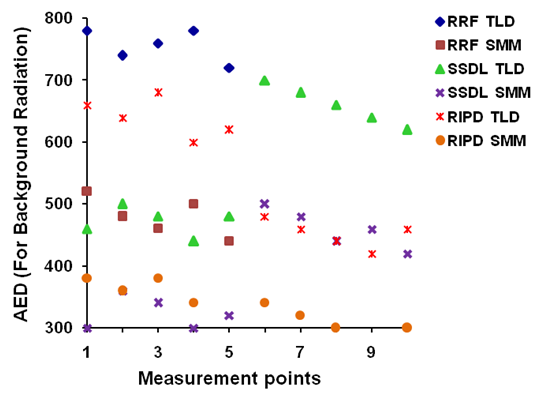 | Figure 14. Comparison of non-operational background AED at different facilities of AERE |
3.5.2. Evaluation of AED for Operational Radiation Level
- The comparative evaluation of AED for operational radiation level of CWPSF, RRF, SSDL and RIPD is presented in Figure 15. These comparative assessments were performed for both SMM and TLD estimated AED. The measured AED for the RR facility was found relatively larger in comparison to CWPSF, SSDL and RID. However, this estimated AED of RRF was found within the IAEA’s recommended AED limit for occupational worker. The AED at some points of LILWSF and SRSSR room of CWPSF was found relatively higher than the SSDL and RIPD facility. Nevertheless, the estimated AED of SSDL and RIPD were found relatively low in comparison to the IAEA’s recommended AED limit for occupational worker.
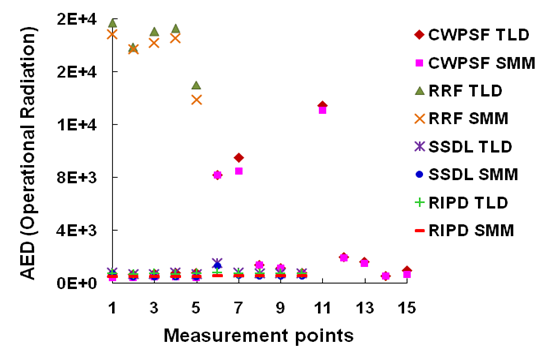 | Figure 15. Comparison of operational AED at different facilities of AERE |
4. Conclusions
- The radiological safety of some radiation generating facilities was verified in terms of the IAEA’s recommendation for the occupational worker, trainee and the public. Subsequently, a comparative evaluation of these estimated AED was performed among CWPSF, RRF, SSDL and RIPD facilities. The estimated AED around the RR facility was found slightly less than the recommended annual dose limit of occupational worker. The AED for CWPSF, SSDL and RIPD facilities was found far below the IAEA’s recommended annual dose lime for occupational worker. However, the investigated AED for public and trainee in some facilities (LILWSF and SRSSR of CWPSF, and RRF) was found relatively high than IAEA’s recommended annual dose limits. Nevertheless, the observed AED would not raise a safety concern for the public and trainee due to their relatively short stay time at distant position. In particular, as the trainees usually spend less time length in comparison to 8 h/d during training course as well as public entrance is generally restricted at the radiation facilities so the estimated AED could be considered as a conservative approach in their case.
 Abstract
Abstract Reference
Reference Full-Text PDF
Full-Text PDF Full-text HTML
Full-text HTML